
![]()
![]()
| 1999 NSF Annual Report
YEAR-FIVE DEB-9505031, $1,248,815, 15 August 1999--31 July 2000 BIODIVERSITY OF THE KURIL ARCHIPELAGO INTERNATIONAL KURIL ISLAND PROJECT (IKIP)
|
|
GOALS.--Following the success of our 1994 "proof of concept" award
(see 1994 NSF Project Report), and Years One,
Two, Three, and Four of the present grant (see
1995, 1996, 1997,
and 1998 NSF
Annual Reports), the primary goal of this sixth expedition to the Kuril
Archipelago was to survey the southern end of Kamchatka, an important source
biota for the Kurils, and to return to various islands throughout the chain,
places of special interest that required additional collecting. Reflecting a
change in the scope of the project, approved by NSF in January 1996, we
determined to redirect efforts and resources toward invertebrates (primarily
terrestrial insects) at the expense of birds and mammals (see
Island Info). In every way these goals were
met.
|
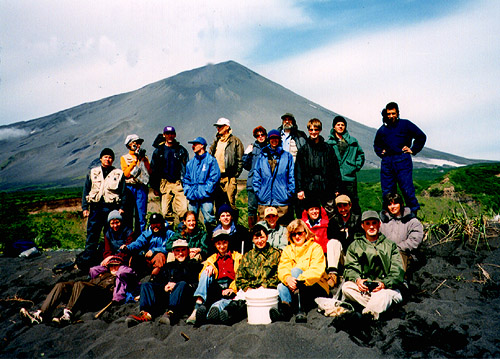 1999 IKIP participants on the coast of Atlasova. Photo by Valery Fadeev.
|
|
RESULTS TO DATE.--An international team of 29 scientists and students (see Project Participants, 1999 Expedition) met in Vladivostok, Russia, on 16 July 1999, boarded the 75-m Akademik Oparin, a research vessel of the Russian Academy of Sciences, and spent 27 days in the field. Fourteen islands were visited--Atlasova, Shumshu, Paramushir, Onekotan, Ekarma, Shiashkotan, Matua, Rasshua, Yankicha, Ketoi, Simushir, Chirpoi, Iturup, and Kunashir--as well as the east and west coasts of Kamchatka. Collections were made at 883 sites (see IKIP Databases and Map-based locality record browser) in widely varying habitats, similar to those collected in previous years (see Macro- and microhabitats of the Kuril Islands): from sea-level sandy-, rocky-beach, and grassland to high-mountain stream/conifer forest; from deep, slow-moving lowland rivers to fast-flowing gravelly streams; and from sphagnum bogs to high mountain lakes.
|
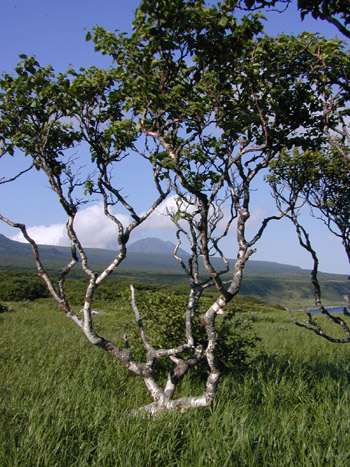 A lonely Erman's birch tree, Betula ermanii, on the central Kuril Island of Simushir. Photo by Dan Bennett.
|
Collecting was confined primarily to vascular plants, aquatic and terrestrial insects, spiders, freshwater and anadromous fishes, amphibians, and reptiles (collections of fungi, lichens, mosses, liverworts, pseudoscorpions, decapods, water fleas, centipedes, millipedes, and marine fishes were also made). In addition to some bad weather, certain uncontrollable difficulties inherent in the project repeated themselves this year (such as impenetrable vegetation making adherence to transects impossible and difficult shore landings at some sites). However, the political problems we experienced in 1994 of gaining access to certain islands and to sites within islands did not reoccur. Our research vessel, the 75-m Akademik Oparin, which also served as our base of operations in 1996 and 1998 (the 68.8-m Professor Bogorov was used 1994, 1995, and 1997) was very comfortable and ably managed by its Russian crew of 34 (see Russian Research Vessels).
|
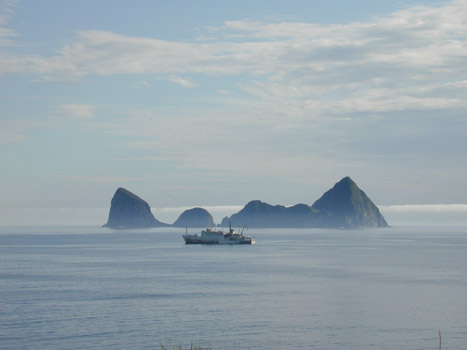 Our research vessel, the 75.5-meter AKADEMIK OPARIN, lying off the coast of Kamchatka. Photo by Dan Bennett.
|
|
RESEARCH PRODUCTS.--Although counts are still preliminary, approximately 54,177 specimens were successfully exported to the U.S. (compared to 63,235 specimens exported in 1998; 53,155 in 1997; 63,700 in 1996; 45,080 in 1995; and 29,600 in 1994):
|
  Cypripedium yatabeanum from Yavinskaya Lake, Kamchatka (left), and Lysichiton camschatcense from the northern Kuril island of Paramushir (right). Photos by Sarah Gage.
|
| Plants: about 2,332 specimens of vascular plants, representing 62 families and at least 265 species; plus about 2,536 specimens of lichens (included here among plants for convenience only) and 1,028 bryophytes (mosses and liverworts), for a grand total of approximately 5,896 specimens; this material includes at least six new records of vascular plants for various islands and, among lichens and bryophytes, at least 15 new records for the Archipelago. Aquatic insects: 8,668 specimens, representing 29 families and a minimum of 162 species, of which 14 represent new records for various islands and 5 represent new records for the Archipelago. Terrestrial insects: 28,323 specimens, representing 17 orders, about 90 families, and perhaps as many as 650 species; the material undoubtedly includes new taxa and many new records, but less than half the collection has been sorted to species and much is not yet even sorted to family. For a comprehensive report on aquatic and terrestrial insects, see IKIP Insect Report.
|
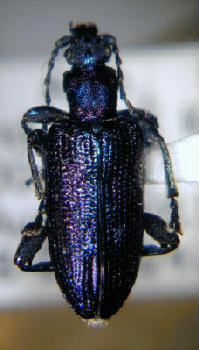
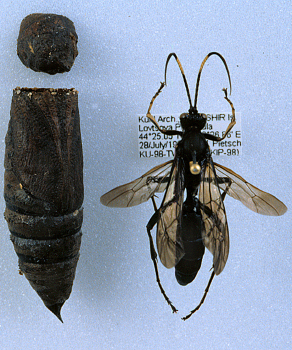
A chrysomelid beetle, Plateumaris sericea Linnaeus (left), and an ichneumonid parasitoid wasp of the subfamily Ichneumoninae, reared from a sphinigid moth cocoon (right) Photos by Brian Urbain (left) and Patricia L. McGiffert and Brian Urbain (right). |
|
Spiders and harvesters: about 2,150 specimens, representing 18 families and about 94 species; the material contains at least one new species (Meioneta sp.), five new records for various islands, and one new record for the Archipelago; many additional new records and new species may be expected, but much of the material remains to be identified. Freshwater fishes: 6,888 specimens, eight families, and 19 species, one of which (Luciogobius guttatus collected on Kunashir) is a new record for the Archipelago; five other species represent new records for various islands; Platichthys stellatus, a marine flatfish, was recorded for the first time from freshwater habitats of Iturup, Paramushir, and Shumshu. Marine fishes: 2,124 specimens, nine families, and 37 species, including one new island record (the stichaeid, Alectridium aurantiacum new for Yankicha), two additional specimens of a cottid identifed last year as new to science (Icelinus n. sp.), and 56 specimens of another cottid (Porocottus sp., similar to P. camchaticus) that appears to be new. Amphibians and reptiles: 35 specimens, three families, and three species.
|
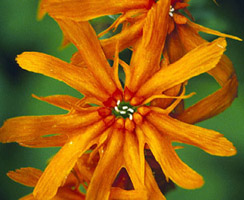 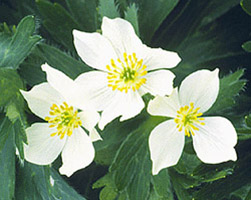 Lychnis fulgens from Primorskii Krai (left) and Anemone narcissiflora from the northern Kuril Island of Onekotan (right). Photos by Sarah Gage.
|
|
The plants, insects, spiders and harvesters, fishes, amphibians, and reptiles, are presently being identified and cataloged here at the University of Washington in the Department of Botany, Burke Museum of Natural History and Culture, and School of Aquatic and Fishery Sciences. General oversight of the insects (i.e., loans of specimens, data compilation, etc.) is being coordinated by Brian K. Urbain (a veteran of IKIP since its inception); all entomological material will be eventually archived in the Department of Entomology at the California Academy of Sciences, San Francisco. Curatorial work on the vertebrates is well in hand, but much remains to be done with the plants, and other invertebrates despite great progress on insects during the past year: under Brian Urbains direction, assisted by undergraduates Daniel J. Bennett and Elizabeth Freeman, and graduate student Sharon J. Collman (see Human Resource Development, below), all Hymenoptera and Coleoptera collected since 1994--over 41,000 specimens--have now been fully curated (specimens pinned and labeled).
|
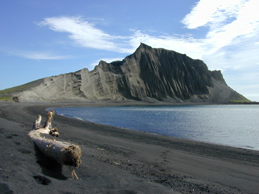
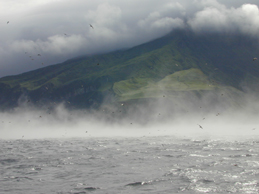 Eroded sand cliffs on the northern Kuril island of Atlasova (left), and a stormy day looking toward the coast of Ekarma. Photos by Dan Bennett.
|
|
Considerable time and effort has gone toward creating, maintaining, and updating an IKIP web-site, the heart of which is our search gateway. To search taxonomic and locality data in a forms base search page go to IKIP Databases. To search locality information only in a map-based record browser, go to Map Browser. Information is also available on Loans and Gifts of IKIP material (please note that our IKIP web-site was developed without the use of NSF funds). Since our return from the Kurils in September 1999, we have been working hard to make all our data available electronically, but dealing with tens of thousands of specimens, it has been a major undertaking. All of our locality data, from 1994 through 1999, are on-line (6,232 sites on 30 islands, plus the mainland of Kamchatka) and we have entered 19,242 taxonomic records (nearly double last year's total). To date, all of the following have been identified, cataloged, and made available on the web-site: all vascular plants, lichens, mosses, liverworts, Odonata, Plecoptera, aquatic Coleoptera, silphid Coleoptera, cerambycid Coleoptera, and Trichoptera collected from 1994 through 1998; Araneae (spiders), Opiliones (harvesters), Acari (mites), Lithobiomorpha (stone centipedes), Ephemeroptera, heteropteran Hemiptera, carabid Coleoptera, phorid Diptera, and formicid Hymenoptera collected from 1994 through 1997; all Cladocera, Dermoptera, Neuroptera, fishes, amphibians, and reptiles collected from 1994 through 1999; all Psocoptera, sternorrhynchan Hemiptera, and mollusks collected in 1994 and 1995; all histerid and cholevid Coleoptera collected in 1995; all syrphid Diptera collected in 1997; and all braconid and bethylid Hymenoptera collected in 1996 (see Table 1).
|
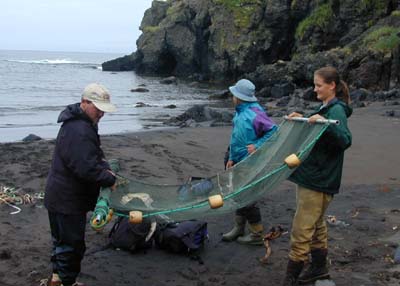 Graduate students Duane E. Stevenson and Erin L. MacDonald handling the seine on the shores of Iturup, with Japanese participant Mamoru Yabe standing by. Photo by Dan Bennett.
|
|
HUMAN RESOURCE DEVELOPMENT.--Four University of Washington undergraduates, Suzanne L. Joneson (plants), Daniel J. Bennett (terrestrial insects), Cynthia A. Catton (terrestrial insects and fishes), and Kemper L. Kurowski (aquatic insects) (the latter two supported by REU funds, see below), and two University of Washington graduate students, Erin L. MacDonald and Duane E. Stevenson (fishes), all full participants in the 1999 expedition, received training in field work, curatorial practices, and systematics within their areas of interest. Their experience continues here at home as collections are being sorted and identified, and publications prepared. REU supplemental support received in 1999 was well used. One of the two recipients, Cynthia A. Catton, now a senior zoology major at UW, assisted in the collection of some 28,323 terrestrial insects and 9,100 freshwater and marine fishes, which she helped to sort, label, and identify, much of the work accomplished while still aboard the research vessel. Since first becoming associated with the Kuril Island Project in 1998, she has become especially interested in marine invertebrates--since our return from the Kurils in September 1999, she has spent much time working more or less on her own at the UW Friday Harbor Laboratories collecting and identifying syllid polychaetes. After graduation in spring 2000, I have every expectation that she will apply to graduate schools to further her studies in this area.
|
 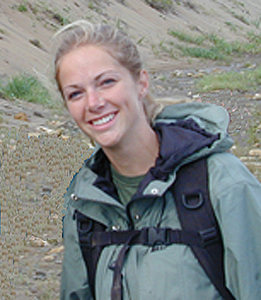 1999 REU participants, Cynthia A. Catton (left) and Kemper L. Kurowski (right), both University of Washington zoology majors. Photos by Dan Bennett.
|
|
Kemper L. Kurowski, the second recipient of 1999 REU support and also now a senior zoology major at UW, assisted in the collecting, preserving, sorting, and identifying of aquatic insects during the 1999 expedition, helping to bring back 8,668 specimens. After our return to campus, she curated aquatic insects collected during previous IKIP expeditions. This work included changing ethanol in all vials and organizing the vials by taxon and locality. She also compiled six-year data for over 21,000 caddisfly specimens, including data from Russian and Japanese scientists, and created species and distribution lists for publication. As a result of her experience last summer, she has become especially interested in dytiscid beetles and is presently a co-author of a paper on this group with two of our Japanese colleagues: Minakawa, N., K. L. Kurowski, and M. Yabe, Submitted, Salinity tolerance of the diving beetle (Hygrotus impressopunctatus: Dytiscidae) and its implication for insect dispersal, Canadian Journal of Zoology. Two veterans of the 1998 expedition, undergraduates Suzanne L. Joneson (plants) and Daniel J. Bennett (terrestrial insects) performed brilliantly for us again this year. During the winter and spring of 1999, prior to last summers expedition, Suzanne (in collaboration with botany research assistant Eugenio Santiago) identified specimens of about 320 species of vascular plants collected during our 1998 expedition. She also transferred locality and taxonomic data from the IKIP Paradox database to the BIOTA/4D database used in the UW Herbarium. With members of the Seattle Lichen Group, she identified Kuril Island macrolichens to genus and many groups to species. She also prepared a number of loans to specialists around the world. During spring quarter, she presented a talk entitled "Botanical Exploration in the Russian Far East," at the University of Washington Undergraduate Research Symposium, University of Washington, Seattle, 7 May 1999. Prior to the 1999 expedition, Suzanne helped prepare and package botanical supplies and equipment for shipment to Vladivostok. During the expedition itself, she was a full participant, collecting 867 numbers (212 vascular plants, 623 lichens, and 32 bryophytes) in multiple replicates, resulting in over 3,400 specimens. She was energetic and enthusiastic in the field and in the ship's laboratory, where processing specimens and writing notes would go late into the night, seven days a week. In Vladivostok, she made valuable contacts in the Herbarium there, and borrowed specimens to aid in her study of the lichen genus Ramalina. Her work on Kuril Island lichens will result in at least one paper. This past September, she entered graduate school in the UW Department of Botany, where she is now working under the sponsorship of Dr. Harvey (Toby) Bradshaw.
|
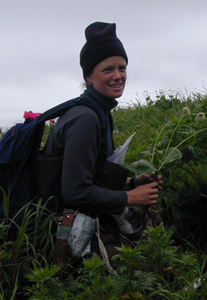 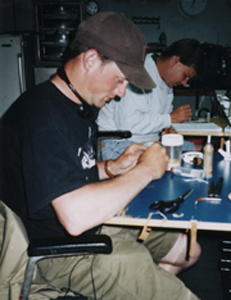 Veteran IKIP-ers hard at work: graduate student in botany Suzanne L. Joneson (left) and recently graduated senior Daniel J. Bennett (right). Photos by Dan Bennett (left) and Elena Sayenko (right).
|
|
Although Daniel J. Bennett graduated from the UW with a B.S. in Zoology in June 1999, his interest and participation in the Kuril Island Project has continued unabated. This past summer, he ably assisted in the collection of approximately 36,991 insects (8,668 aquatic and 28,323 terrestrial), which he helped to sort, label, and identify to order, much of the work accomplished while still aboard the research vessel. Since our return from the Kurils in September, Dan has remained enthusiastic and committed to the project, working almost every day, seven days a week. While responsible over the past two years for curating IKIP Hymenoptera--personally pinning more than 20,000 specimens--he has perfected the basic procedures of curation, from generating labels to pinning specimens, all the steps required to prepare insect material for permanent archival storage and professional research. At the same time, he has developed skills in specialized curatorial methods, such as critical-point drying of alcohol preserved insects, and microscopic glue-point mounting of our smallest and most delicate specimens. He is also corresponding and interacting with systematic entomologists around the world as we send various taxa out on loan for identification. He is now investigating graduate programs in entomology--he plans to specialize in the Braconidae, a family of parasitoid wasps. It is important to emphasize at this point that Brian K. Urbain's contribution to IKIP, since its inception in early 1994 as Project Coordinator, has been extraordinary, especially in coordinating everything related to insects. He has not only organized and supervised the work of all personnel assigned to insects, but has spent untold hours of his own time as well sorting, identifying, and curating material. Early on in the project, Brian developed a strong interest in the Ichneumonidae (another family of parasitoid wasps) and has pinned and identified (to subfamily) nearly all members of this taxon collected in the Kurils over the past six years, more than 8,400 specimens. He is now deeply involved in a study of the scientific literature required to make species-level identifications.
|
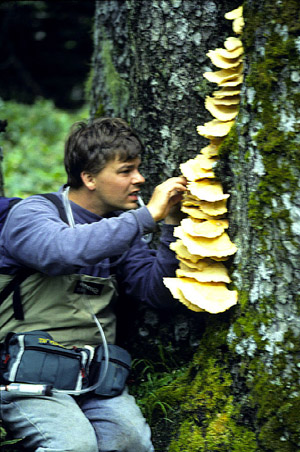 Project coordinator and dedicated veteran of all six IKIP expeditions to date, Brian K. Urbain, extracting insects from bracket fungi. Photo by Dan Bennett.
|
|
Although not members of the 1999 expedition, we received considerable help this past year from four additional UW students: graduate student Sharon J. Collman (School of Forest Resources, Center for Urban Horticulture), and senior undergraduates Elizabeth Freeman (School of Forest Resources, Conservation of Wildland Resources), Jillian A. Kinghorn (Zoology) and Maria M. Ruud (Zoology). Sharon has been largely responsible for getting all IKIP Coleoptera, about 8,000 specimens, pinned and labeled; she has also been instrumental in preparing and making an inventory of the numerous insect loans that have been sent out over the last year. Elizabeths contributions to the project also include the preparation of loans, but her primary focus has been labeling insect specimens; to date she has labeled well over 10,000 specimens, mostly hymenopterans. Since early January 2000, UW undergraduates Jillian Kinghorn and Maria Ruud have been working with spiders and other invertebrates under the supervision of Rod Crawford at the Burke Museum. Despite this short time period, they have already received a diverse exposure to curatorial training. Most of their time has been spent sorting and identifying spiders, data-entry (incorporating taxonomic data on spiders into the IKIP database), cartographic checking of collection localities, and insect pinning and mounting. During the 1999-2000 academic year, we have also provided curatorial training and experience for a number of unpaid volunteers at the Burke Museum. The most productive of these individuals has been Janet Wall who continues to be immensely valuable to us in working with IKIP spiders and harvesters. Over the past year, Janet worked 291 hours, during which time she completed the massive job of double-checking, plotting, and correcting all the locality data for all spiders collected in 1997 and 1998. She did most of the work of cutting, washing, and inserting the final labels into vials, filling and stoppering the vials, and arranging and integrating the material with prior collections. The latter project was completed toward the end of 1999 so that all identified specimens from prior years are now arranged together in a systematic fashion, making it possible to immediately find any specimens needed for research or loans. Janet also processed loans and did other miscellaneous work during the year. LOANS AND GIFTS.--We have worked hard to make our material available to the international scientific community through loans and gifts of specimens. To date, we have made 121 loans and gifts (whole specimens as well as tissues fixed in ethanol) to 89 specialists around the world, totaling 6,158 lots and 55,058 specimens.
|
 A Kuril island sunset marks the end of a long day. Photo by Cindy Catton.
|
|
SEMINARS AND MEDIA ATTENTION.--We have made a concerted effort to inform academic as well as public audiences about IKIP through oral presentation, and have received considerable attention from the media in return. To date, veterans of IKIP have presented 44 popular and scientific talks, and have been the subject of some 43 articles in newspapers and magazines. Our 1996 expedition was recorded in full by three employees of the Hokkaido Television Broadcasting Company (Yasumasa Shinomiya, writer; Osamura Hidetoshi, photographer; and Nikolai Shapotin, interpreter), resulting in a 30-minute television production that was aired in Japan on 2 March 1997. A 90-minute show on the people and general natural history of the Kuril Islands, which aired in April 1997, also featured IKIP-1996. Copies of these videos were made available to NSF in spring 1997. The 1997 expedition was recorded in full by South Korean Television, Soo Yong Park, Producer, but we have not yet received copies of the video. PUBLICATIONS.--Sixty-eight papers have now been published. An additional five are in press, another two have been submitted, and about 22 are at various stages of preparation. Forty descriptions of new taxa have been published or are currently in press or submitted for publication: three new species of caddisflies (Trichoptera: Hydroptilidae, Leptoceridae), two new stoneflies (Plecoptera: Perlodidae), one new beetle (Coleoptera: Carabidae), six new flies (Diptera: Phoridae, Scathophagidae, Syrphidae), one new bug (Hemiptera: Miridae), ten new parasitoid wasps (Hymenoptera: Braconidae), one new genus and two new species of mites (Acari: Acaridae, Eviphidae), one new millipede (Diplopoda: Diplomaragnidae), six new freshwater bivalves (Bivalvia: Unionidae, Anodontidae), five new terrestrial and freshwater gastropods (Gastropoda: Planorbidae, Valvatidae), and three new fishes (Teleostei: Osmeridae, Cottidae, Gobiidae). Among our larger publication efforts is Y. N. Zhuravlev and A. S. Kolyada's book on the biology of ginseng published in 1996: Araliaceae: Ginseng and Other Aralia of the Russian Far East, Dalnauka, Vladivostok, 280 pp., 41 black and white figures, 8 color plates, 11 tables, and 859 bibliographic references. That portion of the book that covers Kuril Island species was funded in part by DEB-9400821 and DEB-9505031; NSF is properly acknowledged on page 1 of the front matter.
|
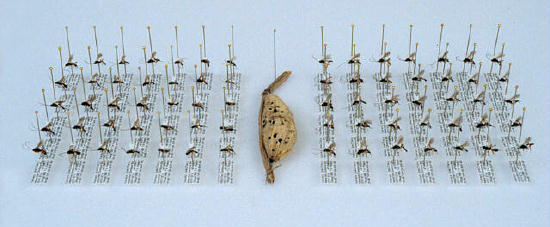
A stunning example of gregarious multiparasitoidism: 78 individuals of these cryptinine ichneumonid wasps, from at least three species, were reared from this moth cocoon that was found attached to a twig of kuril bamboo, Sasa kurilensis. Photo by Patricia L. McGiffert, Elizabeth Freeman, and Brian Urbain.
|
|
Our second larger publication effort, for which we received supplemental support from NSF, is an English translation of G. O. Kryvolutskaja's Entomofauna of the Kuril Islands, originally published in 1973 by the Institute of Biology and Soil Sciences, Far-Eastern Scientific Center, Russian Academy of Science, which is being edited, augmented, illustrated in color, and made available electronically. The book has now been completely translated by Elliott B. Urdang, M.D., M.A. in Russian, of Providence, Rhode Island, and all parts have been delivered to us by diskette and hard-copy: the Abstract, Preface, and Table of Contents (5 pages), Chapter 1, "History of investigations of the insect fauna of the Kuril Islands" (7 pages); Chapter 2, "General information on the insects of the Kuril Islands" (8 pages); Chapter 3, "Accounts of insect taxa of the Kuril Islands" (including methods and materials, keys, descriptions, and general taxonomic accounts by order; 130 pages); Chapter 4, "Ecological and geographic review of the Kuril Island entomofauna" (including physical conditions of the Kuril Islands, ecological features of the Kuril Islands, and insect assemblages and primary habitats of the Kuril Islands; 82 pages); Chapter 5, "Speciation on the Kuril Islands" (10 pages), Chapter 6, "Zoogeography of the Kuril Island entomofauna" (including geological history and floral evolution, zoogeographic origins and trends, and subdivision of the Kuril Archipelago based on insect distributions; 28 pages); Conclusions (4 pages); Summary (2 pages); Literature cited (15 pages), Index of scientific names of insects (19 pages); List of scientific and Russian names of plants (2 pages); all the tables (22); and the legends to all the figures (67). While some of the text requires additional editing, the entire book, including all figures and tables, is now available on the web-site. Color illustration of the work, with photographs taken by members of the IKIP insect team, is in progress. Similar plans to publish electronically V. Y. Barkalov's Plants of the Kuril Islands, are currently on hold while we await delivery of the manuscript. Although promised to us back in June 1997, his approximately 650-page work remains unfinished.
|
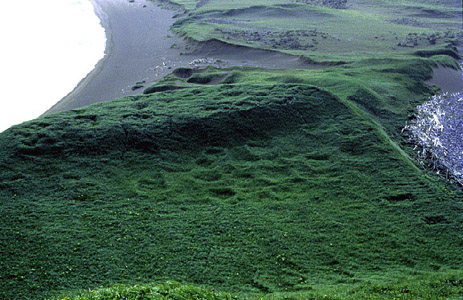 Remains of 44 semi-subterranean pit-houses on the northwestern end of the central Kuril island of Chirpoi. Photo by Tim Allen.
|
|
NEW DIRECTIONS.--As reported last year, the most exciting development in recent years has been the discovery of several undisturbed archaeological sites on various islands throughout the Archipelago. The identification of a possible Ainu site at Nyemo Bay on the uninhabited northern Kuril Island of Onekotan (see Science, 284:583, 23 April 1999) has generated considerable interest from many quarters providing encouragement for us to think broadly about a full-scale paleobiological and biogeographical investigation of the Kuril Archipelago. To help assess the feasibility of such a study, a graduate student from the UW Department of Anthropology, Tim Allen, joined IKIP biologists this past summer, charged with the task of performing a foot survey and visual inspection of possible archaeological sites on the 14 islands that we visited. His report, co-authored by Professor John (Ben) Fitzhugh of the UW Department of Anthropology, identifies a total of 11 archaeological sites: two on islands at the northern end of the chain (Shumshu and Onekotan), five on islands at the southern end (Chirpoi, Iturup, and Kunashir), and four on the southern tip of Kamchatka. These sites generally had a moderate to large number of surface artifacts (ceramics and lithics), but no visible surface features, such as house or pit depressions. One site on Chirpoi, however, contained numerous (we counted 44) semi-subterranean pit-houses clearly visible on the surface. The Allen-Fitzhugh report thus clearly testifies to the potential of the Kuril Islands for significant archaeological history, and we are now confident that a detailed archaeological survey of the Archipelago will be enormously productive.
|
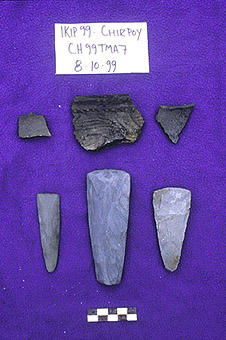 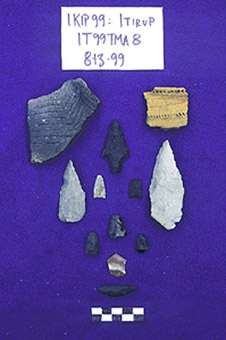 Projectile points, adzes, and decorated ceramic artifacts collected on Chirpoi (left) and Iturup (right). Photos by Tim Allen.
|
|
PLANS FOR SUMMER 2000.--The International Kuril Island Project, which was due to end with the 1999 field season, has now been extended another year, thanks to the foresight and generosity of the National Science Foundation. With this extension of IKIP into the year 2000 (see separate supplemental support requests submitted by Pietsch and Fitzhugh), an unparalleled opportunity exists to explore the historical dimension of Kuril Island biodiversity and biography through archaeological survey and excavation. This supplemental funding will allow preliminary excavation of several sites (most notably the Chirpoi site pictured above) as well as an archaeological survey of other islands in the chain to more fully document the history of human occupation in this remote and poorly studied Archipelago. Archaeological samples (especially animal and plant remains) will contribute to a better understanding of the role of humans in the history of Kuril ecology, and ultimately assist IKIP biologists in explaining the current biodiversity and biogeography of the Kuril Archipelago. We are now in preparation for the coming summer expedition (approximately 20 July--8 September 2000). Our itinerary will be based in large part on localities that have potential for significant archaeological work: Shumshu, Paramushir, Onekotan, Raikoke, Kharimkotan, Matua, Ushishir, Simushir, Chirpoi, Urup, Iturup, and Kunashir. We will also return, however, to various additional islands of special biological interest that require additional collecting (see Map-based locality record browser). Thank you for the generous support we have received. We hope this brief report meets with your satisfaction.
|
![]()
